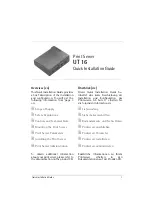
A795 User Guide: Programming Supplement
Chapter 4: Programming commands
108
Download to active flash sector
ASCII
GS DC1 aL aH cL cH d1… dn
Hexadecimal
1D 11 aL aH cL cH d1… dn
Decimal
29 17 aL aH cL cH d1… dn
Value of aL:
low byte of the address
Value of aH:
high byte of the address
Value of cL:
low byte of the count
Value of cH:
high byte of the count
Value of d:
data bytes, 0-255
Value of n (for number of data bytes)
Range of address (aL aH)
Range of count (cL cH)
((cH * 256) + cL)
0000-FFFF (hexadecimal)
0001-FFFF (hexadecimal)
Range:
Addresses run from 0 to 64K.
Contains a start address (aH x 256 + aL) and count (cH x
256 + cL) of binary bytes to load into the selected sector,
followed by that many bytes. The start address is relative
to the start of the sector. Addresses run from 0 to 64K.
The printer may return one of several responses. ACK
means that the data was written correctly and the host
should transmit the next block. NAK means that, for some
reason, the data was not written correctly. This could mean
that communications failed or that the write to flash failed.
The alternatives seem to be to retry the block or halt
loading and assume a hardware failure.
Related information
Available only in download mode.
Download paper type description (ColorPOS™)
ASCII
GS Ox8E nL nH d1 … dn
Hexadecimal
1D 8E m nL nH d1… dn
Decimal
29 142 nL nH d1 … dn
This command will store in flash memory a paper type
description identified by the structure in d1..dn, adding the
uniquely (by type category and version) identified
structure for subsequent use by the set paper type
command. nL+ nH *256 define the number of bytes x that
follow. These bytes contain the proprietary structure and
CRC to operate the thermal print head. This structure
contains the hardware parameter values needed to print on
formulations of monochrome and 2-color thermal papers.
New paper definitions should be obtained from trusted
sources such as the Axiohm web site in order to optimize
print quality while preventing premature head burnout or
other damaging effects.
New definitions do not change any which had already
been set. If an immediate effect is desired, follow up this
command with a set paper type m n (where m n are bytes
0 and 1 of the description). Once stored in flash memory,
this paper type, selectable by ID m n, remains a valid
choice by the set paper type command until firmware
flash memory is erased.
Restrictions: If the value of m n = 0 0, then the command
will be ignored. It is thus impossible to overwrite the
default monochrome paper setting. This command will be
ignored if the head type - carried in the description
(d1…dx) - is incompatible with the head type in the printer
itself or if a description with ID m n already exists.
There is room in firmware flash memory for a maximum
of 16 paper type descriptions; of these one is reserved for
monochrome descriptions, with m n =0 0 description that
is always populated, and factory preload of two color
descriptions. Thus 13 remaining spaces are free for
dynamic use; once these are used up further download
paper type descriptions will be ignored, and a firmware
reload will be necessary to again free up (except for
m n = 0 0) the paper type description space.
















































